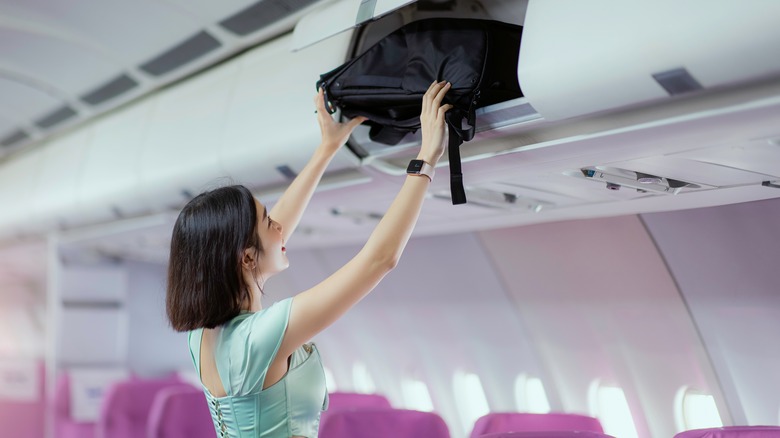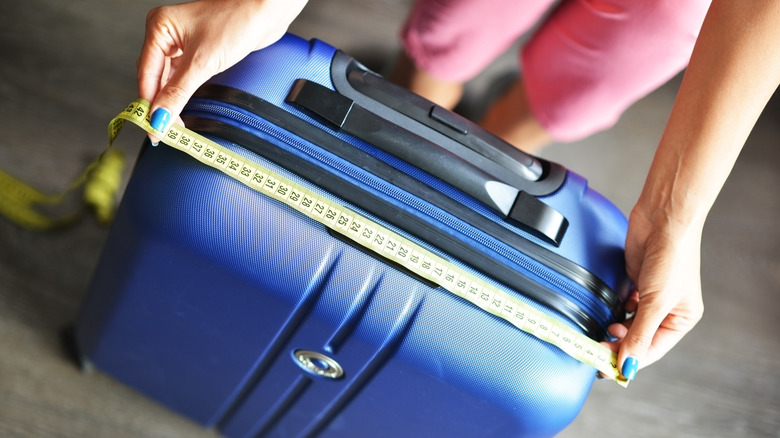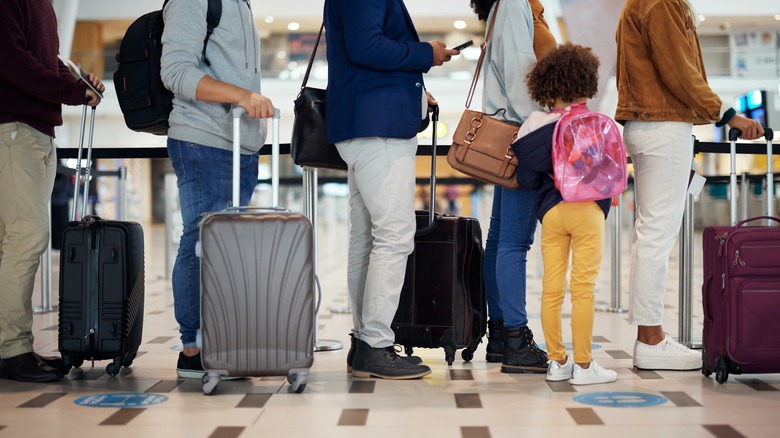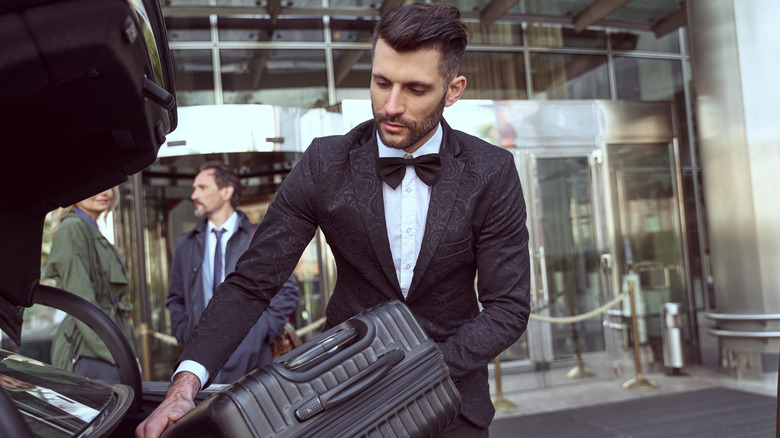Rick Steves Reveals His Tips On Choosing The Best Luggage For An International Trip
Once you decide where you are going, the question of what you will need to bring often becomes the next priority. Ask anyone who has wrestled with a stylish but cumbersome trunk or been hobbled by an ill-fitting backpack: What you pack your things in is just as important as what you bring ... or even more so! European travel expert Rick Steves is known for his down-to-earth advice. When it comes to packing and luggage, it's no surprise he has some great tips for picking the perfect bag. As you are deciding what baggage to bring, or if you are in the market for a new case, he recommends carefully weighing factors such as the size, style, and material of your potential luggage to ensure you are bringing the best bag for your international trip.
The most important aspect of your decision-making process should be what kind of trip you are taking. Hiking through the Alps is going to require a vastly different style of luggage than a luxury Mediterranean cruise. Steves explains that his advice is mainly for people who will be traveling overseas with several stops along the way. For these kinds of trips, he suggests choosing from a soft backpack, an internal-frame backpack, a wheeled carry-on suitcase, or a carry-on-size rolling backpack.
The case for carry-on only
Did you notice something is conspicuously absent from the list of Steves-approved luggage? A bag that requires checking. Rick Steves started as a backpacker in the 1970s, and those roots and devotion to "vagabond magic" show through in his steadfast refusal to lug any more luggage than one carry-on bag and a small daypack, no matter how long his trip will be. As he puts it in a blog post entitled Packing Smart and Traveling Light, "With only a carry-on, I can be nimble at the airport. It's not a hardship to always have my bag with me — it's peace of mind."
Once you land, you can grab your bag and go ... no waiting at the carousel for a bag that hopefully followed you to your destination, which means you get to avoid dealing with airlines when they lose your luggage. And having less stuff to pack means moving from place to place will be less of an ordeal.
Additionally, if you are traveling solo, being able to maneuver all of your luggage by yourself is key. Even though you'll likely be able to find a luggage cart at the airport and big hotels, you are still going to be the one responsible for moving all that baggage. Dragging your oversized case up three flights of stairs in your charming but elevator-less Italian pensione will get old fast! Trust us, you'll be grateful for a petite carry-on-sized case.
Best luggage dimensions when traveling
Rick Steves' strong preference for carry-on over checked luggage is well established. In his article Tips for Choosing the Best Travel Bag, he spells out the best dimensions for luggage. He states you should look for a bag that is no bigger than 14" x 21" x 9" and weighs no more than a generous seven pounds (20 pounds packed). You should be able to find a suitcase that weighs less — even much less — which is a good thing, as a lighter case means you can pack more before reaching your airline's weight limit for cabin bags.
Ensuring your bag falls within the parameters of what the airline allows for carry-on bags is important, as you can face substantial fees if you end up needing to check your bag at the airport. Many airlines have adopted a tiered pricing strategy for checked luggage, with prices increasing the closer you are to take off. So if you know you will require your luggage to be checked, pay for it when you buy your ticket, as that's when the best price is offered. The most expensive option is at the gate. Keep in mind that European ultra-low-cost carriers are among the most strict when it comes to baggage allowance. It is a good habit to compile the allowable bag size for every airline you will be flying with, and then pack according to the most restrictive. You can save tons of space in your luggage with a few game-changing packing hacks.
Roller bags vs. backpacks
Depending on your style of travel and mobility, you will want to consider either a wheeled suitcase or a backpack. Airports are full of passengers pulling their roller bags; they are undeniably popular. The invention of wheeled suitcases is almost as groundbreaking as sliced bread, but don't discount a good backpack. The cobblestone streets of many European towns make dragging a wheeled case a bone-rattling experience. Some backpacks even look quite stylish! Rick Steves recommends backpacks for train travel and for trips to places with loads of stairs — looking at you Cinque Terre and Santorini! He also extols backpacks for the fact that they leave his hands free to do other things, like "eat a sandwich or buy a bus ticket and hop aboard without breaking my stride."
Each style of backpack comes with ups and downs. In the above story, Steves lists a soft-sided backpack as his bag of choice, mainly for its versatility and convenience. He likes that it can squish into most overhead compartments. He also lists internal frame backpacks as good options due to the comfort of having a waist belt to distribute the weight across your hips, although you need to be careful as the height can easily exceed 21". He also gives a nod to rolling backpacks as seemingly "the best of both worlds," but notes the handle and wheels eat up space and that he would opt for either a true backpack or dedicated roller suitcase.
Hard-shell or soft-sided suitcases
If a suitcase feels like the best option for the way you roll, you'll need to determine if you want a hard-sided case or something soft. A heavy gauge nylon suitcase is light, often less expensive than a hard-shell suitcase, and is a better choice in extreme temperatures than a plastic case, particularly if you can't afford one in high-quality ABS. Another advantage to opting for a soft-shell case is that you get a bit more wiggle room. You may be able to slip that extra outfit into a pliant woven suitcase. And if you are faced with a baggage sizer at the airport, you won't have any luck cramming in a rigid case, but a soft case can be more amenable to some desperate squeezing. Rick Steves prefers a soft-shell case both for the price point and due to the fact that they are almost always lighter than a hard-shell case.
On the other hand, many people love hard-sided luggage for lots of good reasons. A case made from aluminum or ABS plastic is durable in all kinds of conditions. It's water-resistant and it will protect your fragile cargo, provided you have cushioned it nicely inside. Another tick in the pro column is that scuffs and accumulated road grime tend to wipe off easily.
Look for durability and comfort
Save yourself the indignity of coming home with your stuff in garbage bags and go for the best quality suitcase you can. That said, price and quality aren't synonymous. In Tips for Choosing the Best Travel Bag, Rick Steves writes, "If your bag costs more than $250, you're probably paying more for a brand name than quality." Rick advises looking for sturdy stitching and ample pockets. If you are going the backpack route, make sure the straps have good padding.
Take a careful look at the areas of a suitcase most likely to fail or cause the biggest headache if they bust: wheels, handle, and zippers. Spinner-style roller bags with four wheels are good for maneuvering over flat surfaces, but not an excellent choice for bumpy roads you might encounter. Four wheels also mean four opportunities for breakage. A two-wheeled roller bag with inset wheels is a good choice for all-round use. Test the handles. Are they comfortable in your hand? Are they reinforced at the attachment points? If it is a telescoping handle, does it extend smoothly? Can you lock it at different heights? Try dragging it along behind you. While it isn't a sign of bad quality if the bag consistently bangs into your ankles, it will get annoying fast. Lastly, inspect the zippers. Having two pulls to open and close the bag is most convenient. Look for strong stitching and no loose threads. Run your thumbnail along the teeth of the zipper — they shouldn't bend. Overall, a quality case sets you up for successful travels!





